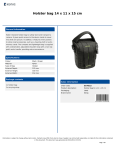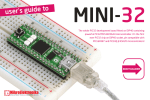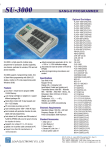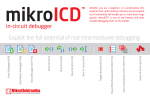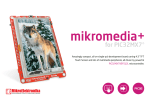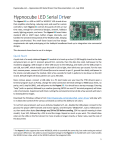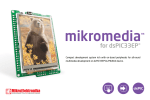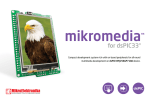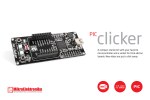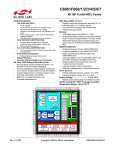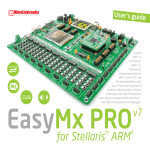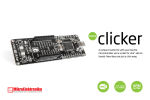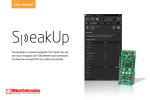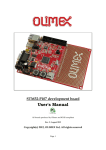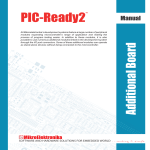Download MINI-M0™ - Mouser Electronics
Transcript
MINI-M0 ™ development board for STM32 The whole STM32 development board fitted in DIP40 form factor, containing high-performance STM32F051R8 ARM Cortex-M0 microcontroller. MINI ARM TO OUR VALUED CUSTOMERS I want to express my thanks to you for being interested in our products and for having confidence in MikroElektronika. The primary aim of our company is to design and produce high quality electronic products and to constantly improve the performance thereof in order to better suit your needs. Nebojsa Matic General Manager The STM32, ARM® and Windows® logos and product names are trademarks of STMicroelectronics®, ARM® Holdings and Microsoft® in the U.S.A. and other countries. Table of Contents Introduction to MINI-M0 for STM32 4 Key features 4 System Specification 5 1. Programming with mikroBootloader 6 step 1 – Connecting MINI-M0 for STM32 6 step 2 – Browsing for .HEX file 7 step 3 – Selecting .HEX file 7 step 4 – Uploading .HEX file 8 step 5 – Finish upload 9 2. Schematic 10 3. Pinout 11 4. Dimensions 12 Page 3 Introduction to MINI-M0 for STM32 Key features Miniature and high-performance development tool designed to work as stand alone device or as MCU card in DIP40 socket. MINI-M0 for STM32 is preprogrammed with USB-UART bootloader so it is not necessary to have external programmer. If there is need for external programmers (mikroProg™ or ST- 01 Connection Pads 02 USB MINI-B connector 03 DATA LED LINK V2) attach it to MINI-M0 for STM32 via pads marked with PA14 (TCK/SWC), PA13 (TMS/ SWD), and RST#. 04 STAT LED 05 POWER supply LED 06 Reset button 07 Power supply regulator 08 Microcontroller STM32F051R8 09 16 MHz Crystal oscillator 10 32.768kHz Crystal oscillator 11 FTDI FT230x chip 12 UART RX LED 13 UART TX LED Page 4 02 System Specification 12 13 01 power supply 07 3.3V via pads or 5V via USB 11 power consumption depends on MCU state (max current into 3.3V pad is 300mA) 08 10 board dimensions 50.8 x 17.78mm (2 x 0.7“) 03 04 05 09 weight ~6g (0.013 lbs) 06 Page 5 1. Programming with mikroBootloader mikroBootloader software You can program the microcontroller with bootloader which is preprogrammed into the device by default. To transfer .HEX file from a PC to MCU you need bootloader software (UART mikroBootloader) which can be downloaded from: note Before starting mikroBootloader software, connect MINI M0 for STM32 to a PC using a USB cable provided with the package http://www.mikroe.com/downloads/get/2055/ mini_m0_bootloader_v220.zip After software is downloaded unzip it to desired location and start mikroBootloader USB UART software. Figure 2-1: mikroBootloader window 01 Page 6 When you start mikroBootloader software, a window as shown in Figure 2-1 should appear Identifying device COM port step 1 – Choosing COM port 01 02 01 03 Figure 2-2: Identifying COM port 01 Figure 2-3: Choosing COM port Open Device Manager window and expand Ports section to see which COM port is assigned to MINI M0 for STM32 (in this case it is COM3) Page 7 01 Click the Change Settings button 02 From the drop down list, select appropriate COM port (in this case it is COM3) 03 Click OK step 2 - Establishing Connection step 3 - Browsing for .HEX file 01 01 Figure 2-4: Connecting with mikroBootloader Figure 2-5: Browse for HEX 01 Press the Reset button on MINI M0 for STM32 board and click the Connect button within 5s, otherwise the existing microcontroller program will run. If connected, the button’s caption will be changed to Disconnect 01 Click the Browse for HEX button and from a pop-up window (Figure 2-6) choose a .HEX file to be uploaded to MCU memory Page 8 step 4 - Selecting .HEX file step 5 - Uploading .HEX file 01 02 01 Figure 2-6: Locating and selecting .hex file Figure 2-7: Begin uploading 01 Select .HEX file using open dialog window. 01 To start .HEX file bootloding click the Begin uploading button 02 Click the Open button Page 9 2. Schematic C13 VDD-3.3V VDD-3.3V VCC-USB C14 2 2.2uF 3 R3 4K7 PA14 VDD-3.3V PB10 PB11 PB7 PB6 PB15 PB14 48 47 46 45 44 43 42 41 40 39 38 37 36 35 34 33 R9 39K VDD-3.3V RESET C1 100nF PA13 VDD-3.3V PA8 PC9 U2 PB15 PB14 PB13 PB12 TX-FTDI VCCIO RXD GND CTS HD2 Page 10 R6 2K2 R7 4K7 LD4 LD5 FT230x GND PAD 1 2 3 4 5 6 7 8 9 10 11 12 13 14 15 16 17 18 19 20 HD1 VDD-3.3V RTS TXD CB3 GND VDD VSS PB9 PB8 BOOT0 PB7 PB6 PB5 PB4 PB3 PD2 PC12 PC11 PC10 PA15 PA14 R8 287K 4 EN ADJ T1 CB2 DP DM 3V3 PA6 PA7 PA5 PA4 PA14 PA13 PC4 PB9 R1 10K USB-D_P USB-D_N 40 39 38 37 36 35 34 33 32 31 30 29 28 27 26 25 24 23 22 21 RF7 RF6 PA13 PA12 PA11 PA10 PA9 PA8 PC9 PC8 PC7 PC6 PB15 PB14 PB13 PB12 PB10 PB11 VDD-3.3V STM32F051R8 GND AP7331-ADJ 220 PA3 PF4 PF5 PA4 PA5 PA6 PA7 PC4 PC5 PB0 PB1 PB2 PB10 PB11 VSS VDD C5 22pF R2 RST# 17 18 19 20 21 22 23 24 25 26 27 28 29 30 31 32 C6 22pF VBAT PC13 PC14 PC15 PF0 PF1 NRST PC0 PC1 PC2 PC3 VSSA VDDA PA0 PA1 PA2 RX-FTDI C2 10pF 1 PC13 2 3 OSC32_IN OSC32_OUT 4 OSC_IN 5 6 OSC_OUT RST# 7 8 PC0 9 PC1 10 PC2 PC3 11 12 13 14 PA0 15 PA1 16 TX-FTDI PA4 PA5 PA6 PA7 PC4 PC5 PB0 PB1 X1 16MHz C4 10pF IN OUT VDD-3.3V U1 X2 32.768KHz 10uF 5 RST# PA0 PA1 PC3 PC5 PC0 PB12 PC1 PC2 PA8 RX-FTDI R4 4K7 64 63 62 61 60 59 58 57 56 55 54 53 52 51 50 49 R5 2K2 LD1 PC12 LD2 LD3 PB9 PC13 PC12 PB7 PB6 PB5 PB4 C11 C10 2.2uF C12 100nF 100nF 100nF C9 VDD-3.3V 1 U3 CB0 CB1 VCC RST PC9 PB4 PB5 PB13 PB0 PB1 R13 VCC-USB 4K7 R15 10K CN1 FP1 USB-D_N USB-D_P C7 100nF 1 2 3 4 5 VBUS DD+ ID GND USB MINIB 3. Pinout Pin functions Pin functions nMCLR PA6 SPI0-MISO PA0 PA7 SPI0-MOSI AN1 PA1 PA5 SPI0-SCK AN3 PC3 PA4 SPI0-SS AN5 PC5 PA14 TCK/SWC AN4 PC0 PA13 TMS/SWD SPI1-SS PB12 PC4 INT0 AN5 PC1 PB9 INT1 AN6 PC2 3.3V 3.3V Power supply INT2 PA8 GND GND 3.3V Power supply 3.3V NC GND GND NC AN0 Analog I/O NC PB10 I2C-SCL NC PB11 I2C-SDA INT3 PC9 PB7 U0RX PWM0 PB4 PB6 U0TX I2C UART0 PWM1 PB5 PB15 SPI1-MOSI SPI1-SCK PB13 PB14 SPI1-MISO PWM2 PB0 NC PWM3 PB1 NC Analog Lines Interrupt Lines SPI Lines Page 11 I2C Lines SPI0 UART lines PWM lines 4. Dimensions 17.78 700 50.8 2000 2.54 100 Legend mm mils Page 12 Notes: Page 13 Notes: Page 14 DISCLAIMER All the products owned by MikroElektronika are protected by copyright law and international copyright treaty. Therefore, this manual is to be treated as any other copyright material. No part of this manual, including product and software described herein, may be reproduced, stored in a retrieval system, translated or transmitted in any form or by any means, without the prior written permission of MikroElektronika. The manual PDF edition can be printed for private or local use, but not for distribution. Any modification of this manual is prohibited. MikroElektronika provides this manual ‘as is’ without warranty of any kind, either expressed or implied, including, but not limited to, the implied warranties or conditions of merchantability or fitness for a particular purpose. MikroElektronika shall assume no responsibility or liability for any errors, omissions and inaccuracies that may appear in this manual. In no event shall MikroElektronika, its directors, officers, employees or distributors be liable for any indirect, specific, incidental or consequential damages (including damages for loss of business profits and business information, business interruption or any other pecuniary loss) arising out of the use of this manual or product, even if MikroElektronika has been advised of the possibility of such damages. MikroElektronika reserves the right to change information contained in this manual at any time without prior notice, if necessary. HIGH RISK ACTIVITIES The products of MikroElektronika are not fault – tolerant nor designed, manufactured or intended for use or resale as on – line control equipment in hazardous environments requiring fail – safe performance, such as in the operation of nuclear facilities, aircraft navigation or communication systems, air traffic control, direct life support machines or weapons systems in which the failure of Software could lead directly to death, personal injury or severe physical or environmental damage (‘High Risk Activities’). MikroElektronika and its suppliers specifically disclaim any expressed or implied warranty of fitness for High Risk Activities. TRADEMARKS The MikroElektronika name and logo, the MikroElektronika logo, mikroC™, mikroBasic™, mikroPascal™, MINI™, EasyMX PRO™, mikroBUS™, Click Boards™, mikroProg™, and mikromedia™ are trademarks of MikroElektronika. All other trademarks mentioned herein are property of their respective companies. All other product and corporate names appearing in this manual may or may not be registered trademarks or copyrights of their respective companies, and are only used for identification or explanation and to the owners’ benefit, with no intent to infringe. Copyright © MikroElektronika, 2014, All Rights Reserved. Page 15 MINI ARM If you want to learn more about our products, please visit our website at www.mikroe.com If you are experiencing some problems with any of our products or just need additional information, please place your ticket at www.mikroe.com/support/ If you have any questions, comments or business proposals, do not hesitate to contact us at [email protected] MINI-M0 for STM32 ver. 1.00 0 100000 025291
















